Pomegranate
![]()
This article explains the plant. See also: pomegranate (heraldry), pomegranate (magazine) or ivory pomegranate.
The pomegranate (Punica granatum), translation from Latin malum granatum ("seeded apple"), is a plant species belonging to the family Lythraceae. The genus Punica, consisting of two species, forms alone the subfamily Punicoideae (Horan.) S.A.Graham, Thorne & Reveal, some authors still list it as its own monotypic family Punicaceae Horan. Its fruit is used in cooking. The distribution area of the pomegranate lies in western to central Asia; today it is cultivated in the Mediterranean region, among other places. Originally, however, the pomegranate comes from the areas of Iran, Afghanistan and northern India.
The genus name Punica is derived from Latin punic(e)us, "Punic", and goes back to the Roman name for the Phoenicians. The German trivial name pomegranate (Middle High German also Margramapfel) and the Latin species name granatum (via granatus from Latin granum, "grain", "kernel", "seed") were coined because of the numerous seeds (Middle High German margramkern, "pomegranate seeds") contained in the fruit.
Description
Appearance and leaf
The pomegranate grows as a deciduous small tree and is often cultivated as a shrub; it reaches heights of up to 5 metres but also higher, grows up to 3 metres wide and can live for several hundred years. The plant parts are bare. The bark is reddish brown to grey, initially smooth, later furrowed, scaly. The young twigs are often square, later becoming grey-brown, stem-round and often ending in a thorn. It is usually deciduous but also evergreen.
The opposite, also whorled or cross-opposite, entire leaves are divided into petiole and leaf blade. The short petioles are 2 to 10 millimetres long. The simple, shiny, dark green leaf blade is 2 to 9 centimeters long and 1 to 2 centimeters wide, lanceolate, elytra-elliptic to obovate-elliptic, or oblong with a narrowing base and a blunt to round-pointed or pointed to spiny upper end. Stipules absent, the venation pinnate with conspicuous median vein depressed above and raised below. The young leaves are partly reddish-green, in autumn the leaves turn yellow.
There are also shrubby dwarf forms with a height of up to about 1 to 1.5 metres, e.g. the dwarf pomegranate tree (as a natural dwarf form Punica granatum var. nana, as a cultivated form Punica granatum 'Nana').
Bloom
The flowering time is usually in spring and summer, in China between March and July, in some regions 2 to 3 flowering times are common. The odourless flowers are terminal, solitary or in small groups at the ends of the twigs. The flowers, which are relatively large with a length of 3.5 to 7 cm and a diameter of 3 to 4 cm, are mostly hermaphroditic urn-shaped or infertile male bell-shaped and have five to nine teeth with a double perianth. There are also intervening tubular flowers, some fertile, with a shortened style. The five to nine fused at the base, waxy-leaved 2 to 4 cm long, fleshy sepals are usually orange-red to pale yellow. They are erect-triangular, with outcurved tips, and form a calyx about 2 to 3 cm long and up to 1.5 cm wide basally. The five to nine red, orange, rarely white; with pale yellow sepals and free, frilly, delicate corollas are obovate with a rounded or blunt upper end at a length of 1.5 to 3 cm and a width of 1 to 2 cm. The stamens, which are very numerous (up to more than 300), are arranged in a circle and may overhang the corolla. The dorsifixed anthers are yellowish-white and the filaments reddish-orange. The pomegranate is self-pollinated or cross-pollinated.
The subequal ovary is 8- to 13-chambered. The fused carpels are superimposed, in different whorls (usually 2 to 3), arranged in the ovary (coenocarp-syncarp). Placentation is central-angular in the lower, parietal in the upper. The stigma is cephalic, trilobate, and lies lower than the anthers.
There are also partially fertile "ornamental pomegranates", sometimes in other colours (pink, yellow), in which the stamens are completely or partially transformed into more petals (petalody).
Fruit and seed
Normally 5 to 12 cm in diameter and weighing 150-500 grams, but also up to 20 cm in size and weighing 500 to over 1000 grams, the spherical, apple-like, initially green, later orange-red, red to yellow-green or yellowish-brown, also black-purple fruit is the borderline case of a leathery berry, since the flesh is not fleshy, but not woody. This special fruit form of the (wild) pomegranate is also called balausta or balaustia (from balaustium or Greek balaustion, "flower of the wild pomegranate tree").
The pomegranate is a pseudo-fruit (anthocarp) formed by the sepals, the receptacle and the gynoecium. It is crowned by the persistent calyx lobes, sometimes forming a collar or a point, and the persistent stamens. The whitish-light reddish, bitter, spongy mesocarp is called the "albedo," as in citrus fruits. This is divided into individual chambers containing the seeds. The dividing walls of these chambers are called "membranes".
The angular, polyhedral (many-sided), ruby-red to pinkish or yellowish-white seeds are surrounded by a glassy, slightly translucent, juicy-flat, tart-sweet "seed coat" (sarcotesta, aril), which easily bursts under pressure. The seeds with "coats" are up to 15 mm long and about 5 to 10 mm wide, the actual soft to hard seeds are ovoid and whitish and about 6 to 10 mm long and 2 to 5 mm wide. The fruit contains about 200 to over 1000 seeds. The thousand-seed mass without a fleshy "seed coat" is about 30 to 40 grams, with it is about 370 to 400 grams.
The fruit opens irregularly when fully ripe. The fruits do not ripen after harvesting, they belong to the non-climacteric fruits. The time to fruit maturity after flowering is about 130 to 175 or slightly more days.
Chromosome set
The chromosome number is 2n = 16 or 18.
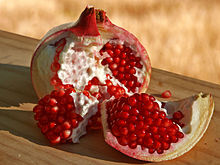
Broken open pomegranate
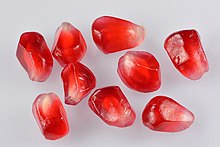
Translucent "seed coats"
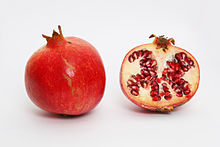
Pomegranate, closed and cut
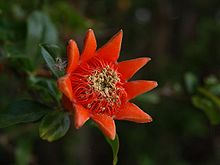
terminal flower
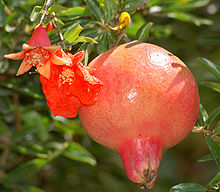
Pomegranate fruit and flowers
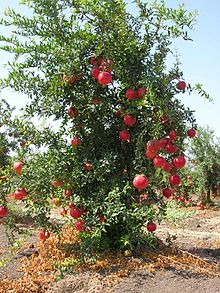
Habitus, foliage and fruits

Open flower with many stamens
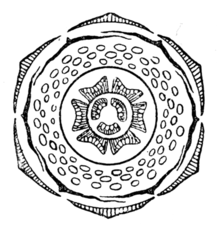
Flower diagram of Punica granatum
Distribution
The distribution area of the pomegranate is in western to central Asia, from Turkey through the Caucasus (Armenia, Azerbaijan, Georgia, southern Russia) and Tajikistan, Turkmenistan and Uzbekistan east to Iran, Afghanistan, Pakistan and China.
In the Mediterranean region and the Middle East, for example in Azerbaijan, Iran, Armenia, Egypt, Spain, Morocco, Tunisia, Syria, Palestine, Israel and Anatolia, the pomegranate has been cultivated for thousands of years (see also horticulture). In India, the pomegranate is cultivated as a spice. The pomegranate also appears in Far East Asia. In Indonesia it is known as delima. Today it is also cultivated in the USA, Chile, South Africa, Australia, Argentina and Brazil.
Some varieties of the pomegranate thrive in regions of Central Europe with mild winters. A shrub blooms, for example, in the front garden of the Museum of Decorative Arts in Budapest or in the Botanical Garden in Halle (Saale). In the course of Spanish colonisation, the pomegranate reached the Caribbean and Latin America. In general, however, the cultivated plant is sensitive to cold; temperatures below 12 °C can damage it. In the dormant phase, however, it can tolerate short frosts that are not too severe. Some varieties from continental climatic regions such as Russia or Uzbekistan are even considered frost-hardy to double-digit sub-zero temperatures and are also grown commercially in Uzbekistan, for example, despite severe winters that can be compared with those in Central Europe. The pomegranate grows best in sandy, well-drained, fertile soils with long, hot summers up to an altitude of 2700 metres. It prefers a sheltered, sunny position and not too much rainfall and survives dry periods well.
.jpg)
A pomegranate in Montenegro.
Questions and Answers
Q: What is a pomegranate?
A: A pomegranate is a fruit-bearing deciduous shrub or small tree that grows between 5 and 10 meters tall.
Q: Where did the pomegranate originate?
A: The pomegranate originated in the region extending from Anatolia to northern India or South Asia.
Q: What family does Punica belong to?
A: Punica belongs to the family Lythraceae, as classified by the Angiosperm Phylogeny Group.
Q: Where is the pomegranate widely cultivated today?
A: The pomegranate is widely cultivated throughout Mediterranean countries today.
Q: Is the pomegranate a symbol of any country?
A: Yes, it is one of the most recognizable symbols of Turkey.
Q: How is it used in drinks in Turkey?
A: It's used in drinks such as Şalgam in Turkey.
Search within the encyclopedia